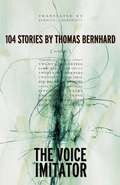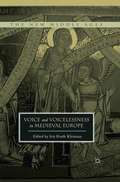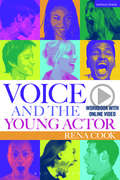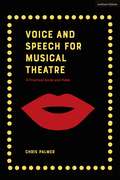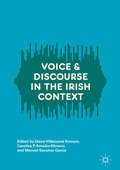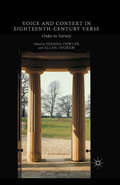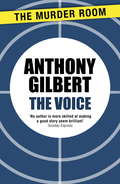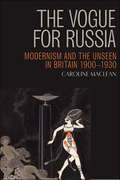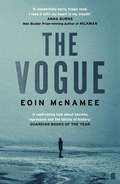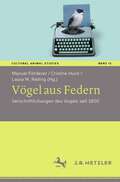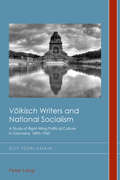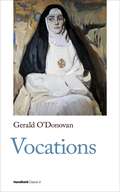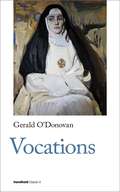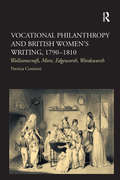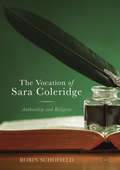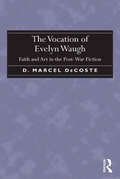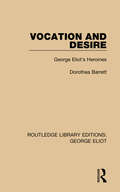- Table View
- List View
The Voice Imitator
by Thomas BernhardThe Austrian playwright, novelist, and poet Thomas Bernhard (1931-89) is acknowledged as among the major writers of our times. At once pessimistic and exhilarating, Bernhard's work depicts the corruption of the modern world, the dynamics of totalitarianism, and the interplay of reality and appearance. In this stunning translation of The Voice Imitator, Bernhard gives us one of his most darkly comic works. A series of parable-like anecdotes—some drawn from newspaper reports, some from conversation, some from hearsay—this satire is both subtle and acerbic. What initially appear to be quaint little stories inevitably indict the sterility and callousness of modern life, not just in urban centers but everywhere. Bernhard presents an ordinary world careening into absurdity and disaster. Politicians, professionals, tourists, civil servants—the usual victims of Bernhard's inspired misanthropy—succumb one after another to madness, mishap, or suicide. The shortest piece, titled "Mail," illustrates the anonymity and alienation that have become standard in contemporary society: "For years after our mother's death, the Post Office still delivered letters that were addressed to her. The Post Office had taken no notice of her death." In his disarming, sometimes hilarious style, Bernhard delivers a lethal punch with every anecdote. George Steiner has connected Bernhard to "the great constellation of Kafka, Musil, and Broch," and John Updike has compared him to Grass, Handke, and Weiss. The Voice Imitator reminds us that Thomas Bernhard remains the most caustic satirist of our age.
Voice and Voicelessness in Medieval Europe (The New Middle Ages)
by Irit Ruth KleimanTwelve medieval scholars from a wide range of disciplines, including law, literature, and religion address the question: What did it mean to possess a voice - or to be without one - during the Middle Ages? This collection reveals how the philosophy, theology, and aesthetics of the voice inhabit some of the most canonical texts of the Middle Ages.
Voice and the Young Actor: A workbook and DVD (Performance Books)
by Rena CookThere are thousands of students enrolled in school drama classes and yet very often young actors cannot be heard, are culturally encouraged to trail off at the ends of sentences, and habitually use only the lowest pitches of the voice. Drama teachers, frequently ask, "How can I get my students to speak up, to be clear, to articulate?" Voice and the Young Actor is written for the school actor, is inviting in format, language and illustration and offers clear and inspiring instructions. A DVD features 85 mins and 28 filmed voice workshop exercises with the author and two students. These students log their reflections in the book on what they have learned throughout their training and there is space for the reader to do the same. A workbook in format, Voice and the Young Actor provides simple, interactive vocal exercises and shows young performers how to take voice work into acting.
Voice and Speech for Musical Theatre: A Practical Guide (Performance Books)
by Chris PalmerVoice and Speech for Musical Theatre is the first book to combine traditional actor vocal training with musical theatre training, offering support and guidance for performers seeking to train their spoken voice specifically for singing and performing in musical theatre.Performers in musical theatre are working harder than ever. The shifting and extreme nature of the modern musical theatre repertoire requires performers capable of mastering musicianship, singing and dancing while at the same time providing convincing and clear performances as actors. Voice and Speech for Musical Theatre will help train musical theatre performers in the longer modes of voice needed to create convincing and moving performances.Ideal for the triple-threat performer, Voice and Speech for Musical Theatre features exercises for performers, tips for teachers and online video resources, allowing for a focused and outcome-oriented training of vocal techniques for musical theatre performers.
Voice and Speech for Musical Theatre: A Practical Guide (Performance Books)
by Chris PalmerVoice and Speech for Musical Theatre is the first book to combine traditional actor vocal training with musical theatre training, offering support and guidance for performers seeking to train their spoken voice specifically for singing and performing in musical theatre.Performers in musical theatre are working harder than ever. The shifting and extreme nature of the modern musical theatre repertoire requires performers capable of mastering musicianship, singing and dancing while at the same time providing convincing and clear performances as actors. Voice and Speech for Musical Theatre will help train musical theatre performers in the longer modes of voice needed to create convincing and moving performances.Ideal for the triple-threat performer, Voice and Speech for Musical Theatre features exercises for performers, tips for teachers and online video resources, allowing for a focused and outcome-oriented training of vocal techniques for musical theatre performers.
Voice and Discourse in the Irish Context
by Diana Villanueva Romero Carolina P. Amador-Moreno Manuel Sánchez GarcíaThis book examines the intersection of culture and language in Ireland and Irish contexts. The editors take an interdisciplinary approach, exploring the ways in which culture, identity and meaning-making are constructed and performed through a variety of voices and discourses. This edited collection analyses the work of well-known Irish authors such as Beckett, Joyce and G. B. Shaw, combining new methodologies with more traditional approaches to the study of literary discourse and style. Over the course of the volume, the contributors also discuss how Irish voices are received in translation, and how marginal voices are portrayed in the Irish mediascape. This dynamic book brings together a multitude of contrasting perspectives, and is sure to appeal to students and scholars of Irish literature, migration studies, discourse analysis, traductology and dialectology.
Voice and Discourse in the Irish Context
by Diana Villanueva Romero Carolina P. Amador-Moreno Manuel Sánchez GarcíaThis book examines the intersection of culture and language in Ireland and Irish contexts. The editors take an interdisciplinary approach, exploring the ways in which culture, identity and meaning-making are constructed and performed through a variety of voices and discourses. This edited collection analyses the work of well-known Irish authors such as Beckett, Joyce and G. B. Shaw, combining new methodologies with more traditional approaches to the study of literary discourse and style. Over the course of the volume, the contributors also discuss how Irish voices are received in translation, and how marginal voices are portrayed in the Irish mediascape. This dynamic book brings together a multitude of contrasting perspectives, and is sure to appeal to students and scholars of Irish literature, migration studies, discourse analysis, traductology and dialectology.
Voice and Context in Eighteenth-Century Verse: Order in Variety
by Allan Ingram Joanna FowlerThis collection of essays reassesses the importance of verse as a medium in the long eighteenth century, and as an invitation for readers to explore many of the less familiar figures dealt with, alongside the received names of the standard criticism of the period.
The Voice (Mr Crook Murder Mystery)
by Anthony GilbertAn ordinary day - which turns to blackmail and murder.Classic crime from one of the greats of the Detection ClubWhat seemed like an ordinary phone call in the middle of the afternoon suddenly plunges its recipient, Simon Crete, into a plot of blackmail and murder.'Tell him it's no use. I haven't got it,' the mystery woman's voice cried desperately down the line. But who was she? And why was she ringing a man whom she had never seen?
The Vogue for Russia: Modernism and the Unseen in Britain 1900-1930 (Edinburgh University Press)
by Caroline MacleanExplores the influence of Russian mystical aesthetics on British modernists, challenging the dominant Western European and transatlantic focus in modernist studies and providing an original contribution to our understanding of new global modernisms.
The Vogue
by Eoin McNameeLate 1944, and two teenagers dance the Vogue in silence on the projectionist's floor of the Pirnmill Aerodrome. She draws the outlines of their footwork in eyebrow pencil on the white sheet. He loses their bet. Decades later, a ghost returns to Morne to identify a body found in the shifting sands. Names have long since been changed; children long since cast out; lies long thought forgotten. Set against an eerie landscape, awash with secrets, The Vogue is a grimly poetic dance through the intertwined stories of a deeply religious community, an abandoned military base, and a long-shuttered children's Care Home.
Vögel aus Federn: Verschriftlichungen des Vogels seit 1800 (Cultural Animal Studies #12)
by Manuel Förderer Cristine Huck Laura M. ReilingDie Beiträge des Bandes bestimmen mit interphilologischem Blick Formen der Literarisierung und Ästhetisierung des Vogels seit 1800 im Kontext aktueller naturpolitischer Diskurse und kulturwissenschaftlicher Theoriebildung. Über Epochen- und Gattungsgrenzen hinweg werden Darstellungs- und Schreibmodi von Mensch-Natur-Verhältnissen untersucht, in denen der Vogel als Reflexionsfigur ökologischer, sozialer und poetologischer Diskurse fungiert. Das Ergebnis ist eine literarisch-ornithologische Bestandsaufnahme in historischer wie systematischer Perspektive, die die Bedeutung des Vogels als Texttier der Moderne unterstreicht.
"Voelkisch" Writers and National Socialism: A Study of Right-Wing Political Culture in Germany, 18901960 (Cultural History and Literary Imagination #21)
by Guy TourlamainThis book provides a view of literary life under the Nazis, highlighting the ambiguities, rivalries and conflicts that determined the cultural climate of that period and beyond. Focusing on a group of writers – in particular, Hans Grimm, Erwin Guido Kolbenheyer, Wilhelm Schäfer, Emil Strauß, Börries Freiherr von Münchhausen and Rudolf Binding – it examines the continuities in völkisch-nationalist thought in Germany from c. 1890 into the post-war period and the ways in which völkisch-nationalists identified themselves in opposition to four successive German regimes: the Kaiserreich, the Weimar Republic, the Third Reich and the Federal Republic. Although their work predated Hitler’s National Socialist movement, their contribution to preparing the cultural climate for the rise of Nazism ensured them continued prominence in the Third Reich. Those who survived into the post-war era continued to represent the völkisch-nationalist worldview in the West German public sphere, opposing both the Soviet and liberal-democratic models for Germany’s future. While not uncontroversial, they were able to achieve significant publishing success, suggesting that a demand existed for their works among the German public, stimulating debate about the nature of the recent past and its effect on Germany’s cultural and political identity and position in the world.
"Voelkisch" Writers and National Socialism: A Study of Right-Wing Political Culture in Germany, 18901960 (Cultural History and Literary Imagination #21)
by Guy TourlamainThis book provides a view of literary life under the Nazis, highlighting the ambiguities, rivalries and conflicts that determined the cultural climate of that period and beyond. Focusing on a group of writers – in particular, Hans Grimm, Erwin Guido Kolbenheyer, Wilhelm Schäfer, Emil Strauß, Börries Freiherr von Münchhausen and Rudolf Binding – it examines the continuities in völkisch-nationalist thought in Germany from c. 1890 into the post-war period and the ways in which völkisch-nationalists identified themselves in opposition to four successive German regimes: the Kaiserreich, the Weimar Republic, the Third Reich and the Federal Republic. Although their work predated Hitler’s National Socialist movement, their contribution to preparing the cultural climate for the rise of Nazism ensured them continued prominence in the Third Reich. Those who survived into the post-war era continued to represent the völkisch-nationalist worldview in the West German public sphere, opposing both the Soviet and liberal-democratic models for Germany’s future. While not uncontroversial, they were able to achieve significant publishing success, suggesting that a demand existed for their works among the German public, stimulating debate about the nature of the recent past and its effect on Germany’s cultural and political identity and position in the world.
Vocations (PDF)
by Gerald O'Donovan‘If we don't sit here where have we to go?’ ‘Well, there's our walk every day. And we are allowed out twice if it is fine, and our boating in summer, and our little visits to the church and to the convents.’ ‘And you're twenty-one and I'm nineteen and a half,’ Kitty said hysterically. ‘My God, what a life!' Gerald O'Donovan's novel Vocations (1921) is set in a small town in late Victorian Ireland, and is a searing indictment of priests competing to acquire girls and their dowries for the church, and exploiting their high social status. Winnie and Kitty Curtin, the two daughters of the wealthy grocer, are being firmly driven towards the Sisters of Mercy by their determined mother. Kitty’s furious resistance to becoming a nun is thwarted by a most unattractive suitor, and Winnie’s glad embrace of the veil is driven by her secret passion for Father Burke. O’Donovan was ordained in 1895, and was a friend of Lady Gregory, W B Yeats and George Moore, and a supporter of Gaelic League. He left the priesthood in 1908 to work in London’s East End, and married in 1910. He had a secret twenty-year affair with the novelist Rose Macaulay: Vocations was written at the height of this relationship. Chrissie Van Mierlo’s introduction explores the literary, cultural and religious background to the novel, and more widely in O’Donovan’s writing.
Vocations (Handheld Classics #4)
by Gerald O'Donovan‘If we don't sit here where have we to go?’ ‘Well, there's our walk every day. And we are allowed out twice if it is fine, and our boating in summer, and our little visits to the church and to the convents.’ ‘And you're twenty-one and I'm nineteen and a half,’ Kitty said hysterically. ‘My God, what a life!' Gerald O'Donovan's novel Vocations (1921) is set in a small town in late Victorian Ireland, and is a searing indictment of priests competing to acquire girls and their dowries for the church, and exploiting their high social status. Winnie and Kitty Curtin, the two daughters of the wealthy grocer, are being firmly driven towards the Sisters of Mercy by their determined mother. Kitty’s furious resistance to becoming a nun is thwarted by a most unattractive suitor, and Winnie’s glad embrace of the veil is driven by her secret passion for Father Burke. O’Donovan was ordained in 1895, and was a friend of Lady Gregory, W B Yeats and George Moore, and a supporter of Gaelic League. He left the priesthood in 1908 to work in London’s East End, and married in 1910. He had a secret twenty-year affair with the novelist Rose Macaulay: Vocations was written at the height of this relationship. Chrissie Van Mierlo’s introduction explores the literary, cultural and religious background to the novel, and more widely in O’Donovan’s writing.
Vocational Philanthropy and British Women's Writing, 1790–1810: Wollstonecraft, More, Edgeworth, Wordsworth
by Patricia ComitiniPatricia Comitini's study compels serious rethinking of how literature by women in the late-eighteenth and early-nineteenth centuries should be read. Beginning with a description of the ways in which evolving conceptions of philanthropy were foundational to constructions of class and gender roles, Comitini argues that these changes enabled a particular kind of feminine benevolence that was linked to women's work as writers. The term 'vocational philanthropy' is suggestive of the ways that women used their status as professional writers to instruct men and women in changing gender relations, and to educate the middling and laboring classes in their new roles during a socially and economically turbulent era. Examining works by Hannah More, Mary Wollstonecraft, Maria Edgeworth, and Dorothy Wordsworth, whose writing crosses generic, political, and social boundaries, Comitini shows how women from diverse backgrounds shared a commitment to philanthropy - fostering the love of mankind - and an interest in the social nature of literacy. Their writing fosters sentiments that they hoped would be shared between the sexes and among the classes in English society, forging new reading audiences among women and the lower classes. These writers and their writing exemplify the paradigm of vocational philanthropy, which gives people not money, but texts to read, in order to imagine societal improvement. The effect was to permit the emergence of middle-class values linking private notions of morality, family, and love to the public needs for good citizens, industrious laborers, and class consolidation.
Vocational Philanthropy and British Women's Writing, 1790–1810: Wollstonecraft, More, Edgeworth, Wordsworth
by Patricia ComitiniPatricia Comitini's study compels serious rethinking of how literature by women in the late-eighteenth and early-nineteenth centuries should be read. Beginning with a description of the ways in which evolving conceptions of philanthropy were foundational to constructions of class and gender roles, Comitini argues that these changes enabled a particular kind of feminine benevolence that was linked to women's work as writers. The term 'vocational philanthropy' is suggestive of the ways that women used their status as professional writers to instruct men and women in changing gender relations, and to educate the middling and laboring classes in their new roles during a socially and economically turbulent era. Examining works by Hannah More, Mary Wollstonecraft, Maria Edgeworth, and Dorothy Wordsworth, whose writing crosses generic, political, and social boundaries, Comitini shows how women from diverse backgrounds shared a commitment to philanthropy - fostering the love of mankind - and an interest in the social nature of literacy. Their writing fosters sentiments that they hoped would be shared between the sexes and among the classes in English society, forging new reading audiences among women and the lower classes. These writers and their writing exemplify the paradigm of vocational philanthropy, which gives people not money, but texts to read, in order to imagine societal improvement. The effect was to permit the emergence of middle-class values linking private notions of morality, family, and love to the public needs for good citizens, industrious laborers, and class consolidation.
The Vocation of Sara Coleridge: Authorship And Religion
by Robin SchofieldThis book presents a fundamental reassessment of Sara Coleridge. It examines her achievements as an author in the public sphere, and celebrates her interventions in what was a masculine genre of religious polemics. Sara Coleridge the religious author was the peer of such major figures as John Henry Newman and F. D. Maurice, and recognized as such by contemporaries. Her strategic negotiations with conventions of gender and authorship were subtle and successful. In this rediscovery of Sara Coleridge the author revises perspectives upon her literary relationship with Samuel Taylor Coleridge. Far from sacrificing her opportunities in service of her father’s memory, her rationale is to exploit his metaphysics in original religious writings that engage with urgent controversies of her own times. Sara Coleridge critiques the Oxford theology of Newman and his colleagues for authoritarian and elitist tendencies, and for creating a negative culture in religious discourse. In response, she experiments with methodologies of collaborative, dialogic exchange, in which form as much as content will promote liberal, inclusive and productive encounters. She develops this agenda in her major religious work, the unpublished Dialogues on Regeneration (1850–51), which this book examines in its penultimate chapter.
The Vocation of Sara Coleridge: Authorship and Religion
by Robin SchofieldThis book presents a fundamental reassessment of Sara Coleridge. It examines her achievements as an author in the public sphere, and celebrates her interventions in what was a masculine genre of religious polemics. Sara Coleridge the religious author was the peer of such major figures as John Henry Newman and F. D. Maurice, and recognized as such by contemporaries. Her strategic negotiations with conventions of gender and authorship were subtle and successful. In this rediscovery of Sara Coleridge the author revises perspectives upon her literary relationship with Samuel Taylor Coleridge. Far from sacrificing her opportunities in service of her father’s memory, her rationale is to exploit his metaphysics in original religious writings that engage with urgent controversies of her own times. Sara Coleridge critiques the Oxford theology of Newman and his colleagues for authoritarian and elitist tendencies, and for creating a negative culture in religious discourse. In response, she experiments with methodologies of collaborative, dialogic exchange, in which form as much as content will promote liberal, inclusive and productive encounters. She develops this agenda in her major religious work, the unpublished Dialogues on Regeneration (1850–51), which this book examines in its penultimate chapter.
The Vocation of Evelyn Waugh: Faith and Art in the Post-War Fiction
by D. Marcel DeCosteArguing against the critical commonplace that Evelyn Waugh’s post-war fiction represents a decline in his powers as a writer, D. Marcel DeCoste offers detailed analyses of Waugh's major works from Brideshead Revisited to Unconditional Surrender. Rather than representing an ill-advised departure from his true calling as an iconoclastic satirist, DeCoste suggests, these novels form a cohesive, artful whole precisely as they explore the extent to which the writer’s and the Catholic’s vocations can coincide. For all their generic and stylistic diversity, these novels pursue a new, sustained exploration of Waugh’s art and faith both. As DeCoste shows, Waugh offers in his later works an under-remarked meditation on the dangers of a too-avid devotion to art in the context of modern secularism, forging in the second half of his career a literary achievement that both narrates and enacts a contrary, and Catholic, literary vocation.
The Vocation of Evelyn Waugh: Faith and Art in the Post-War Fiction
by D. Marcel DeCosteArguing against the critical commonplace that Evelyn Waugh’s post-war fiction represents a decline in his powers as a writer, D. Marcel DeCoste offers detailed analyses of Waugh's major works from Brideshead Revisited to Unconditional Surrender. Rather than representing an ill-advised departure from his true calling as an iconoclastic satirist, DeCoste suggests, these novels form a cohesive, artful whole precisely as they explore the extent to which the writer’s and the Catholic’s vocations can coincide. For all their generic and stylistic diversity, these novels pursue a new, sustained exploration of Waugh’s art and faith both. As DeCoste shows, Waugh offers in his later works an under-remarked meditation on the dangers of a too-avid devotion to art in the context of modern secularism, forging in the second half of his career a literary achievement that both narrates and enacts a contrary, and Catholic, literary vocation.
Vocation and Desire: George Eliot's Heroines (Routledge Library Editions: George Eliot)
by Dorothea BarrettFirst published in 1989. Generations of critics have seen George Eliot as a conservative Victorian high moralist and sybil. Vocation and Desire questions that image, and finds in her work elements of anger, feminism, subversiveness, revenge, iconoclasm, wit, and eroticism – elements that we have been taught not to expect. After looking at the development of the sybilline image and the gradual eclipse of the subversive George Eliot – which Eliot herself initiated – Dorothea Barrett goes on to investigate the evidence of the novels themselves and finds an alternative emphasis. Her study of the heroines of the six major novels and issues of language and desire provides a refreshing and acute analysis of the contradictions and strengths of Eliot’s work. She also considers the reception of George Eliot by feminist critics and the broader implications of her work for contemporary feminism. This title will be of interest to students of literature.
Vocation and Desire: George Eliot's Heroines (Routledge Library Editions: George Eliot #2)
by Dorothea BarrettFirst published in 1989. Generations of critics have seen George Eliot as a conservative Victorian high moralist and sybil. Vocation and Desire questions that image, and finds in her work elements of anger, feminism, subversiveness, revenge, iconoclasm, wit, and eroticism – elements that we have been taught not to expect. After looking at the development of the sybilline image and the gradual eclipse of the subversive George Eliot – which Eliot herself initiated – Dorothea Barrett goes on to investigate the evidence of the novels themselves and finds an alternative emphasis. Her study of the heroines of the six major novels and issues of language and desire provides a refreshing and acute analysis of the contradictions and strengths of Eliot’s work. She also considers the reception of George Eliot by feminist critics and the broader implications of her work for contemporary feminism. This title will be of interest to students of literature.
